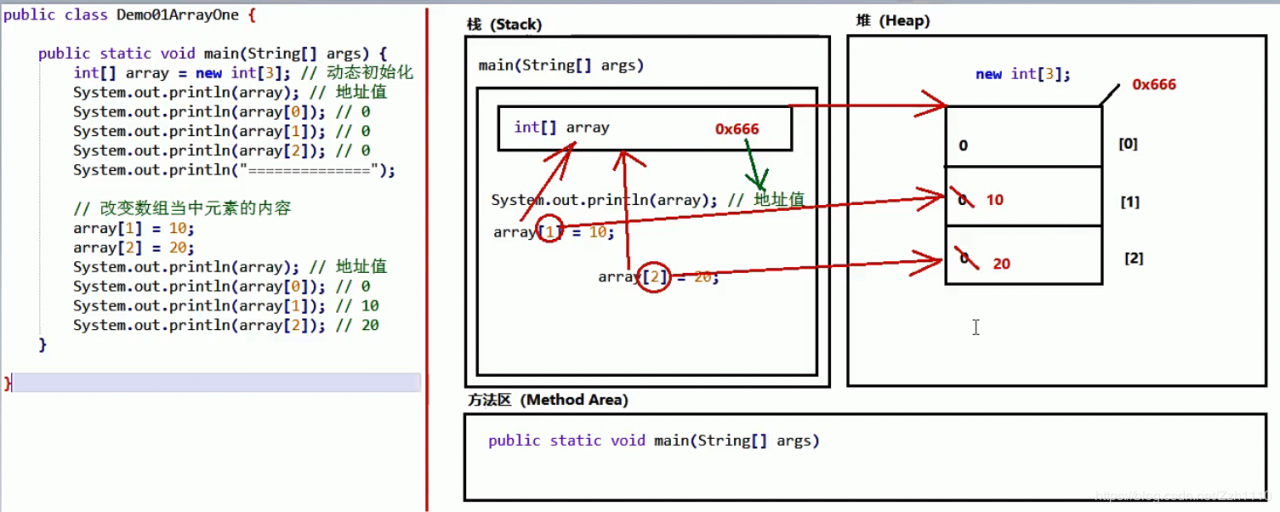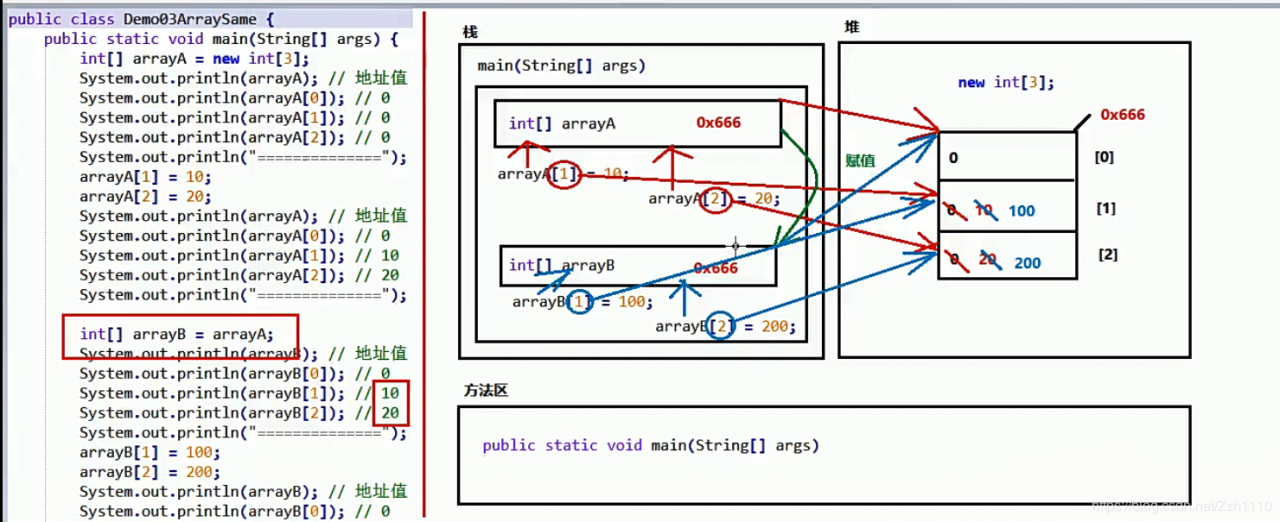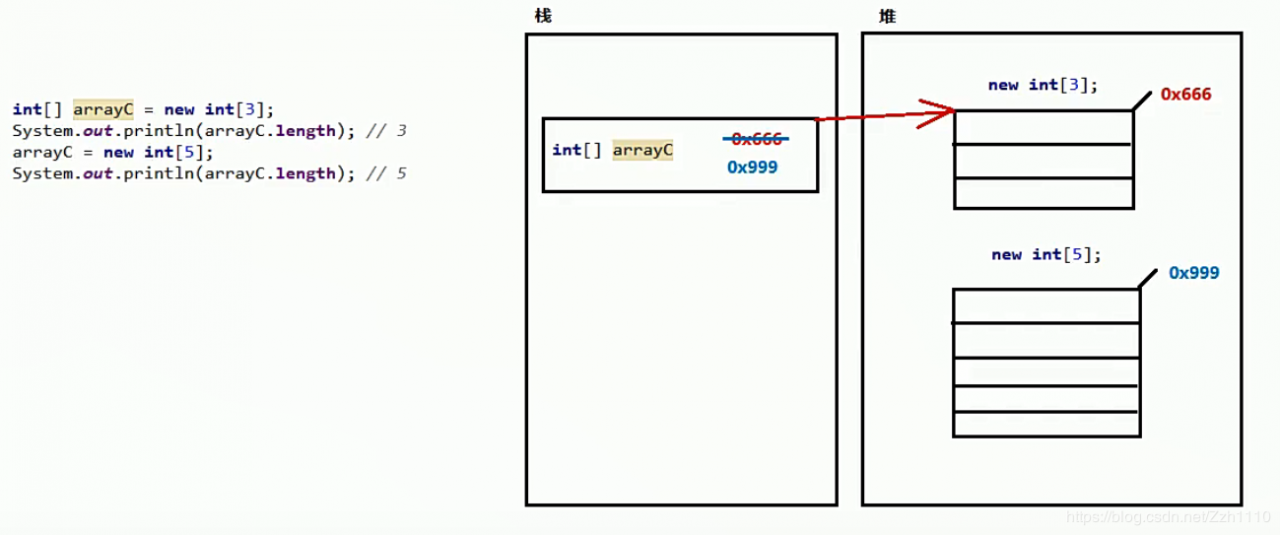JavaSE--内存与数组
重学JavaSe后的补充
Java面向对象总结
Java基础总结
Java中的内存可以划分为五个模块:
①栈内存(Stack):存放的都是方法中的局部变量。方法的运行一定要在栈当中运行。
②堆内存(Heap):凡是new出来的东西,都在堆内存中。堆内存都有地址值:16进制。
③方法区(Method Area):存储.class相关信息,包含方法的信息。
④本地方法栈(Native Method Stack):与操作系统相关。
⑤寄存器(pc Register):与CPU相关。
2.数组 1)数组是什么:int i1,i2,...i100,一共写100个变量
这样写有点繁琐,数组的出现就是为了解决这个。
一组相关变量的集合。
2)数组的特点:是引用数据类型;数组长度不可变
3)数组的创建: I.动态初始化(指定长度):数据类型[] 对象数组名称 = new 数据类型 [长度];
int[] arrayA = new int [5];
II.静态初始化(指定内容):
标准格式:
数据类型[] 对象数组名称 = new 数据类型 []{ …, … , …}
省略格式:
数据类型[] 对象数组名称 = { …, … , …}
int [] arrayB= new int[] {11,22,33};
int [] arrayC= {44,55,66};
III.使用建议:
如果不确定数组当中的具体内容,用动态初始化;确定了具体内容,则最好使用静态。
4)获取数组元素:格式:数组名称[索引值]
索引值从0开始,一直到"数组长度-1"为止。
动态初始化数组并循环输出:
public class Test {
public static void main(String[] args) {
int data [] = new int[3];
data[0] = 10;
data[1] = 20;
data[2] = 30;
for(int x=0;x<data.length;x++){
System.out.println(data[x]);
}
}
}
5)数组的内存图:

根据地址[0x666]找到数组。
引用传递:同一块堆内存空间,能被不同的栈访问。

索引超过了数组的长度。
ArrayIndexOutOfBoundsException异常。
int[] array = {10,20};
System.out.println(array[2]);
7)数组长度的不可变性:
xx.length即可获得数组的长度。
只用你new了,数组的长度就永远不可变。(变了的只是新数组,地址值发生改变)

任何数据类型都能作为方法参数或者返回值类型,数组也不例外。
当调用方法的时候,向方法的小括号进行传参,传递进去的其实是数组的地址值。
public class Demo {
public static void main(String[] args) {
int array[] = {10,20,30,40,50};
printArray(array);
}
public static void printArray(int array[]){
for (int i = 0; i < array.length; i++) {
System.out.println(array[i]);
}
}
}
9)数组作为方法的返回值类型:
当有多个返回值时,就可以使用数组。
public class Demo {
public static void main(String[] args) {
int result [] = calculate(10,20,30);
System.out.println("总和"+result[0]);
System.out.println("平均数"+result[1]);
}
public static int[] calculate(int a,int b, int c){
int sum=a+b+c; //总和
int avg= (a+b+c)/3; //平均数
/*int array[] = new int[2]
array[0]=sum;
array[1]=avg
*/
int array [] ={sum,avg};
return array;
}
}
10)冒泡排序
(利用java.util.Arrays.sort() 也可以完成排序)
public class Test10 {
public static void main(String args[]){
int data [] = new int [] {
9,7,6,8,4,5,1,3,2,
};
sort(data);
print(data);
}
public static void sort(int temp[]){
int t;
for(int x=0;x<temp.length;x++){
for(int y =0;ytemp[y+1]){
t = temp[y];
temp[y] = temp[y+1];
temp[y+1] = t;
}
}
}
}
public static void print(int temp2[]){
for(int x=0;x<temp2.length;x++){
System.out.print(temp2[x]);
}
System.out.println();
}
}
11)数组反转
public class Test10 {
public static void main(String args[]){
int data [] = new int [] {
1,2,3,4,5,6,7,8
};
reserve(data);
print(data);
}
public static void reserve(int temp[]){
int len = temp.length /2;
int head = 0;
int tail = temp.length - 1;
for(int x=0;x<len;x++){
int a ;
a = temp[head];
temp[head] = temp [tail];
temp[tail] = a;
head ++;
tail --;
}
}
public static void print(int temp2[]){
for(int i =0;i<temp2.length;i++){
System.out.println(temp2[i]);
}
}
}
12)对象数组:
数组是引用类型,而类也是引用类型,对象数组就表示一个引用类型里面嵌套其他的引用类型。
对象数组的初始化和数组的一样,上面的数组是属于基本数据类型的数组。
对象数组的初始化:
类名称[] 对象数组名称 = new 类名称[长度]
类名称[] 对象数组名称 = new 类名称 []{ ..., ... , ...}
作者:迷途小羔羊。
相关文章
Fredrica
2020-11-10
Urania
2020-03-04
Miette
2023-06-06
Serafina
2023-06-06
Tanisha
2023-07-20
Jacinthe
2023-07-20
Mathilda
2023-07-20
Tia
2023-07-20
Hellens
2023-07-20
Opal
2023-07-20
Thalia
2023-07-20
Olive
2023-07-20
Dara
2023-07-20
Angie
2023-07-20
Rhea
2023-07-20
Catherine
2023-07-20
Antonia
2023-07-20
Rae
2023-07-20
Winola
2023-07-20
Lark
2023-07-21